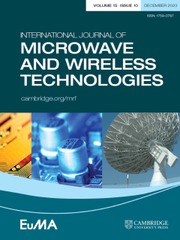Design and analysis of an energy selective rasorber
Published online by Cambridge University Press: 13 October 2023
Abstract
By combining the technique of energy selective surface and frequency selective rasorber, an energy selective rasorber is proposed, which performs selective energy protection in the low communication frequency band (0.8–2 GHz) and wave-absorbing property in the high-frequency band (6–18 GHz). The design consists of two layers, of which the bottom one contains a lumped diode structure for energy selection function in the transmission band, while together with the top layer, they perform a wideband wave absorbing function. The simulated and measured results agree well with each other, and both show good absorption in 6–18 GHz and energy-selective property around 1.86 GHz. That is, when the incident power changes from −30 to 14 dBm, the reflection coefficient changes from below −22 dB to above −2 dB, while the transmission coefficient changes from above −3 dB to below −17 dB.
Keywords
- Type
- Metamaterials and Photonic Bandgap Structures
- Information
- International Journal of Microwave and Wireless Technologies , Volume 16 , Issue 2 , March 2024 , pp. 237 - 243
- Copyright
- © The Author(s), 2023. Published by Cambridge University Press in association with the European Microwave Association
References
A correction has been issued for this article:
- 1
- Cited by
Linked content
Please note a has been issued for this article.



